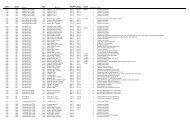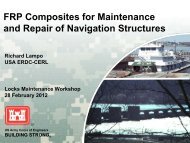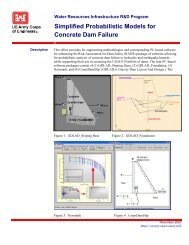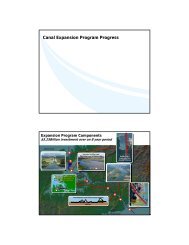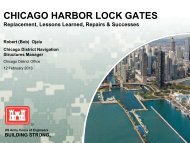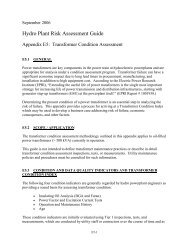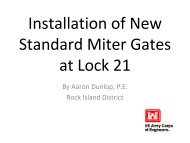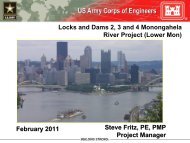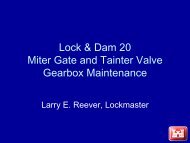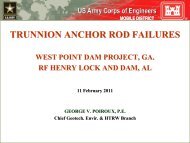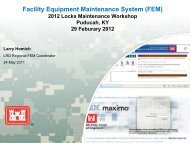Testing Post-Tensioned Steel Trunnion Rods for the U. S. Army ...
Testing Post-Tensioned Steel Trunnion Rods for the U. S. Army ...
Testing Post-Tensioned Steel Trunnion Rods for the U. S. Army ...
- No tags were found...
Create successful ePaper yourself
Turn your PDF publications into a flip-book with our unique Google optimized e-Paper software.
<strong>Testing</strong> <strong>Post</strong>-<strong>Tensioned</strong> <strong>Steel</strong> <strong>Trunnion</strong> <strong>Rods</strong><strong>for</strong> <strong>the</strong> U. S. <strong>Army</strong> Corps of EngineersMark A. Cesare, , PhDmcesare@fdh-inc.comJ. Darrin Holt, PhD, PEholt@fdh-inc.comFDH Engineering, Inc. (919) 755 1012Raleigh, NCSt. Louis, MOBaton Rouge, LA
<strong>Trunnion</strong> Anchor <strong>Rods</strong>
The Problem• Some Catastrophic Rod Failures• Loss of Pre-Stressing (grip nut slippage,relaxation, etc.)• Unknown Initial / Existing Tensions• Typical Solution = Mechanical Lift-Off• New Solution = Nondestructive <strong>Testing</strong> (NDT)by Dispersive Wave Propagation (DWP)
Approach to <strong>the</strong> Problem• Feasibility investigation at West Point: Canthis even be done?• Lab models and full-scale trunnionassembly prototype.• Wide spread testing.• Mechanical lift-off.• Calibration / Validation• Dispersive Tension Equation (DTE).
Background on <strong>the</strong> <strong>Testing</strong> Method• Dispersive Wave Methodsas used <strong>for</strong> foundation testing• FHWA / NCDOT Researchin 1989 <strong>for</strong> Bridge Piles• Used in 50 States, PR,USVI, El Salvador• Used by several States andmany private corporations
The “Idea”Dispersive Flexural Wave MotionStrike with a HammerThe WaveGrip NutEmbedded EndFlexural wave velocities and response depend upon:MaterialCross-SectionTension
The Nondestructive Field <strong>Testing</strong>“Light” impacts create <strong>the</strong> dispersive waves.Wave motion captured and recorded.Data analyzed <strong>for</strong> response.Tension determined from response curves.
Field <strong>Testing</strong>
Accessibility Issues
Modeling <strong>the</strong> <strong>Steel</strong> Covers• Built full size cover boxwith PVC <strong>for</strong> rods• Helped develop customstrikers (“Hammer on astick”)• Developed and practicedtesting procedures
Tackling AccessibilityEach rod had to be measured& “pinged”– non-trivial problem thru <strong>the</strong>port hole openings– Remote camera had to beused
<strong>Trunnion</strong> Assembly Prototype• Rein<strong>for</strong>ced concrete withtubes <strong>for</strong> rods and testequipment.• Designed and built at FDH
Allows <strong>for</strong> modeling ofmany damconfigurations.<strong>Trunnion</strong> Prototype
DWP Response with Tension23.5 in Live-End26 in Live-End28 in Live-EndResponse (Hz)30 in Live-EndMeasured (Known) Load (kips)West Point Configuration
DWP Response with TensionRobert F. Henry Configuration
Dispersive Tension EquationAfter per<strong>for</strong>ming lift-off tests, <strong>the</strong> Dispersive TensionEquations (DTE) were derived (1 st generation):“Long” Live-End Lengths (as West Point)T 181.8 * f1 123.1*C 24.55 * f1 2 0.67 * f 2 2 1099 * f 2 f 2f1 7.73* f1* f 2 2.272 * f1*C 14746.56“Short” Live-End Lengths (as RF Henry)T 12245.4 10.4C 0.0027 f 1 0.0019 f 2 4.9615 f 1 0.0179L 18888.0d 7314.7d 2 f 2
DTE Results – West Point, GA+ 8.6 k- 8.6 kMeasured (Known) Load (kips)West Point Standard Error : +/- 8.6 kips
DTE Results – Robert F. Henry+ 8.6 k- 8.6 kMeasured (Known) Load (kips)R.F. Henry Standard Error : +/- 2.6 kips
Greenup, KY104 rods testedIdentified one failed rodNo lift-offs as of yet
Advantages• Can be pre<strong>for</strong>med w/ high level of safety.• No standing in front of rods.• Easily applied.• No additional stress added to <strong>the</strong> rods.• Can test 80 to 100 rods per day(approximately).
Thank You !
Response Results - R. F. HenryTypical <strong>Rods</strong>?Pier 3Typical <strong>Rods</strong>Observed frequency correlatedto exposed lengthKnown failures are outliersO<strong>the</strong>rs are well below <strong>the</strong>“Typical” rodsPiers 1, 2, and 3 built bydifferent contractor than 4 thru12, and several years apartResponse (Hz)Length (in)Failed <strong>Rods</strong>Left in damUnder-tensioned/possible failures
Greenup ResultsMost rods ~50 Hz10 3Intact RodBroken rod 43 HzLift-off test inplanning phaseAmplitude10 210 1Broken Rod10 010 2 10 3Response (Hz)
Greenup, KY Results56Observed responsecorrelated to exposedlengthOne extreme outlier <strong>for</strong>broken rodResponse (Hz)F1 (Hz)545250484644424023.5 24.0 24.5 25.0 25.5(in)Length (in)
<strong>Trunnion</strong> Assembly ResultsRod typically testedat 25 different loadsfrom 0 to 115,000lbper setupAt no load – we getnoisy FFTsSmall load start tobring out peaksMode of vibration ofcantilever clearAll f’s increasingwith loadNo Load19.8 Hz55,150 lb46.92 Hz5000 lb33.95 Hz111,780 lb48.06 Hz
Results – <strong>Trunnion</strong> PrototypeLarge increases infrequency at lowloads60FrequencyAbove ~20,000 lbpattern of slow butsteady increase infrequency withtensionFrequency (Hz)504030204847.5104750000 70000 90000 11000000 20000 40000 60000Load (lb)80000 100000 120000
Results – <strong>Trunnion</strong> PrototypeMany tests done at different lengths and loads3000.02500.0Fully Loaded350300Response (Hz)2000.01500.01000.0500.0Lower Loads25020015010050Lower Loads0.000 1 2 3 4 25 26 27 28 29 30 31Length (in)
Preparing <strong>for</strong> liftoff tests• Test custom made gripping devices• Strain gages to determine actual pre-stressin rods• Generated ma<strong>the</strong>matical relation betweenreported liftoff load and preset load in rod
Liftoff Tests Results• West Point - 109 rods liftoff tested– 7 lifted (110k to 115k)– 102 did not lift• R. F. Henry – 90 rods liftoff tested (not alldata reviewed)– 70 lifted !!!! (99k to 113k)– 20 did not lift• Greenup – 10 tests planned <strong>for</strong> 2011
West Point DataResponse (Hz)Length (in)
Length (in)R. F. Henry DataResponse (Hz)
The Dispersive Tension EquationAn equation relating tension to DWP responseThe “DTE” estimated tension with +/- 1 Std. Dev. (+/-8.0 K)
FDH Approach to <strong>Trunnion</strong> <strong>Rods</strong>• Non destructive to rods– Widespread lift-off not required (in general)– Load in rod never changes• Low risk to rods and personnel– Crews need only access to side of rods– Danger zone in front of rod avoided
FDH Approach to <strong>Trunnion</strong> <strong>Rods</strong>• Low impact on operations– Temporary structures not needed– Crane not needed• About 1/10 <strong>the</strong> cost of liftoff testing• Results +- 7.5 k
Current Approach• Measure all rods (length and diameter)• Record lateral acceleration from impact• Do liftoff tests on 5-10% of rods• Use Liftoff tests and analytic model tocreate a calibrated equation (specific to <strong>the</strong>dam)• Estimate loads in rods not liftoff tested
Future• With better modeling and ongoing datacollection eliminate need <strong>for</strong> liftoff tests• Once liftoff test are done calibration curvesand be reused <strong>for</strong> same dam• Real time monitoring of vibration frequency(passive test still had useable frequencycontent)
Thank you
Preliminary Tests• Built prototype testsetups• Ga<strong>the</strong>red data <strong>for</strong>proof of concept
Greenup <strong>Rods</strong>• Grip nut integralwith face plate• “Insert” directly inface plate
Failures at West Point DamAll brittle failuresFlaw size at failure veryconsistentBackgroundFailures between 5 and15 feet from dead endWhat happens when arod having 115K oftension catastrophicallyfails?
Slipped Grip Nuts at R. F. Henry• Two with Grip nutseparated from faceplate• One slipped• Three with brittlefailures & ejection.• <strong>Rods</strong> were found tobe intact
A Methodical Research Project• FDH approached by Corps in 10/2008 with problem.• Preliminary experiments on Lab models• West Point – Feasibility tests (April 2009) – 37 rods• A <strong>Trunnion</strong> Assembly Full-Scale Model – Extensive testing• Collect field data at West Point (376 rods) and RF Henry (476 rods)• FDH testing / DYWIDAG demonstration lift-off tests on prototype• Liftoff <strong>Testing</strong> (West Point & RF Henry - 216 rods)• Greenup Dam, Greenup, KY testing (one pier)• Calibration of FDH results = Dispersive Tension Equation (DTE)
West Point Dam
Robert F. Henry Dam
Greenup, KY Dam
West Point <strong>Trunnion</strong> <strong>Rods</strong>26 to 30 inches exposed<strong>Rods</strong> accessed through 24” by12” opening
R. F. Henry <strong>Trunnion</strong> <strong>Rods</strong>21 rods per group2 groups per Tainter Gate11 Gates2 end groups of 7 rods476 rods totalASTM A322-64, Grade 51601 ¼” Diameter145k Ultimate Tensile StrengthAnchor plate at far endRod Length 412” to 508”<strong>Rods</strong> are in tubes w/ NO-OXOX-ID Grease<strong>Rods</strong> from same manufacturer and lot asWest Point rods
<strong>Trunnion</strong> Model <strong>Rods</strong>Various rod lengthsCouplers to attachactual rodfragments fromWest Point Dam
Lift-Off TestsOn site practice liftofftests at FDH facilityin Raleigh, NC• Dorsey & Dorsey• DYWIDAG• Corps ofEngineers
Preparing <strong>for</strong> liftoff tests• Close up of custom(DSI) grip-nutgripper• Feeler gagechecks <strong>for</strong> stretchin free part of rod
• <strong>Rods</strong> also tested by“Listening” as gateswere opened andclosed• Same dominantresponses observed• In fact, sameresponses observedby just attachingsensors<strong>Testing</strong> <strong>the</strong> <strong>Rods</strong>
Modeling <strong>the</strong> <strong>Rods</strong>2-D, 3D (future) Beam Finite Element Model of RodSimple supports at face of trunnion beam and far endAdditional rotational springsTension between supports onlyDispersive Data AnalysisStrike with a HammerThe Wave
West Point ResultsCollectedacceleration timehistories ofimpactsUse DWP to findresponse contentIdentify first dominantmodes of motion2.5 x 104 21.510.50-0.5-1-1.5-2-2.50 0.5 1 1.5 2 2.5Ti ( )10 410 310 210 110 010 -110 -210 -310 -1 10 0 10 1 10 2 10 3 10 4
West Point ResultsObserved responsecorrelated to exposedlengthTwo rods are much shorterbut appear to fall in linewith responseNo extreme outliersAll rods appear to be intactResponse (Hz)Length (in)
R. F. Henry DamR. F. Henry rods have manymodes that are close to <strong>the</strong>live-end response10 310 2Broken RodClear, single responsepeaks may not be seenDWP from broken and intactrods at R. F. Henry showsame pattern as no load andfully load case from mockupAmplitude10 110 010 -110 -2Intact Rod10 -310 0 10 1 10 2 10 3 10 4 10 5 10 6Response (Hz)
<strong>Trunnion</strong> Assembly Full-Scale Model
Greenup <strong>Trunnion</strong> <strong>Rods</strong>52 rods per group2 groups per Tainter GateOnly 1 pier tested1 1/8” Diameter~125,000 lb tensile capacityAnchor plate at far endAll rods same length (924”)<strong>Rods</strong> are in tubes with NO-OXOX-IDGrease
Preparing <strong>for</strong> Field Lift-Off Tests• West Point testssimulated (below)• 28 inch rods• Actual Rod salvagedfrom West Point• R. F. Henry testssimulated (above)• 2-4 inch rods• Gripper attaches to gripnut NOT rod directly
West Point ResultsObserved response correlated to exposed lengthNo extreme outliersAll rods appear to be intactResponse (Hz)Live-End (in)
Robert F. Henry ResultsTypical <strong>Rods</strong>Response (Hz)Failed <strong>Rods</strong>Left in damLive-End (in)Under-tensioned <strong>Rods</strong>
<strong>Trunnion</strong> Anchor Rod AssemblyTransfers Tainter gate <strong>for</strong>ces to dam.Upwards to 115K post-tension load.



